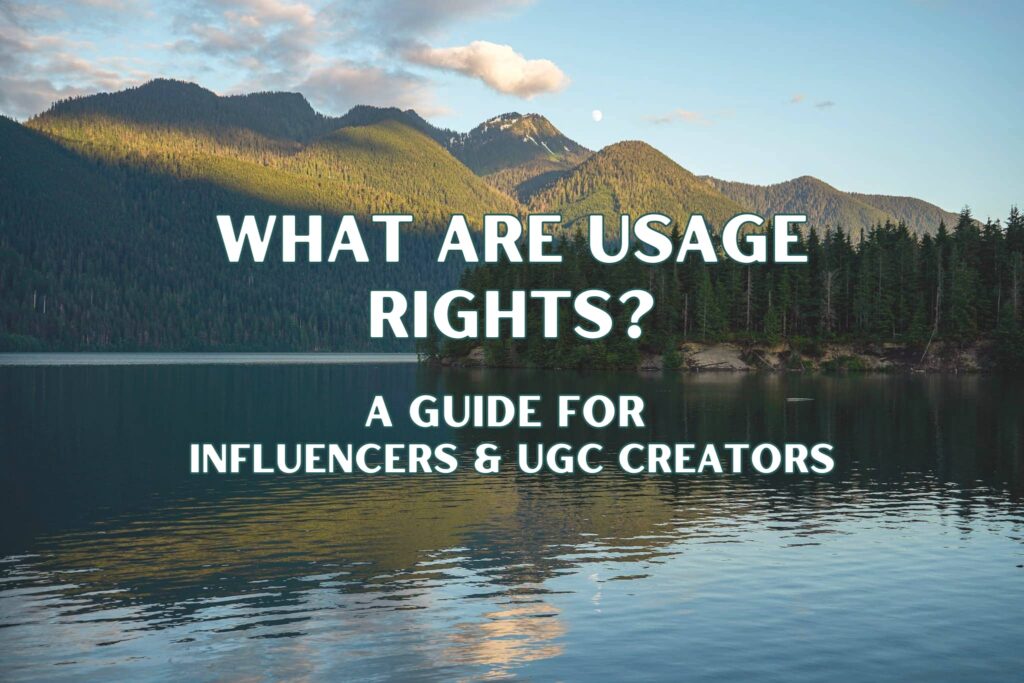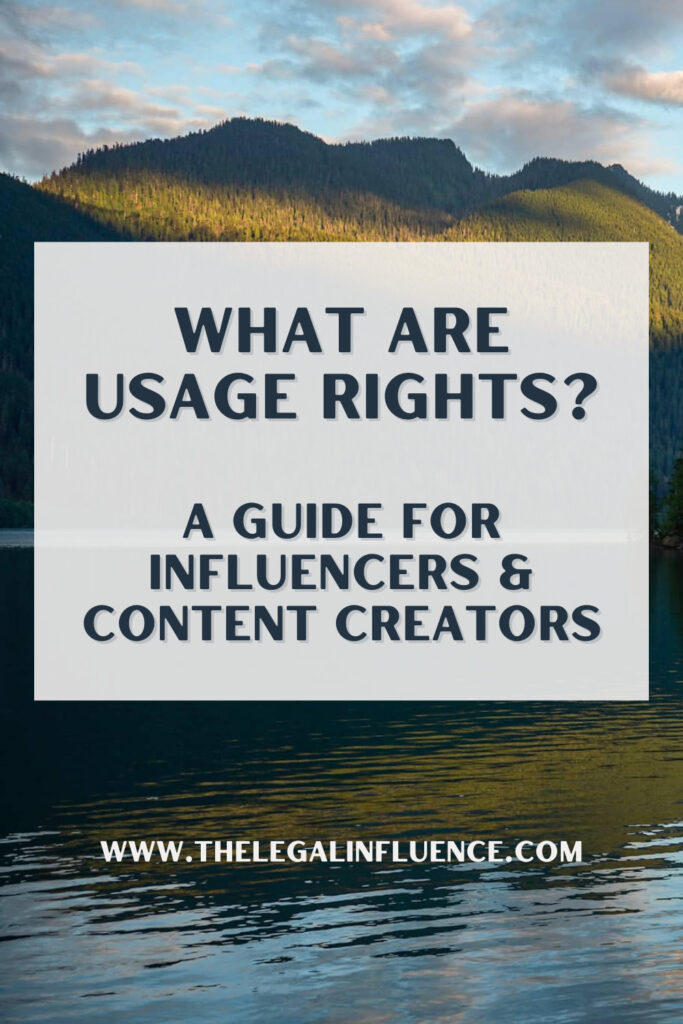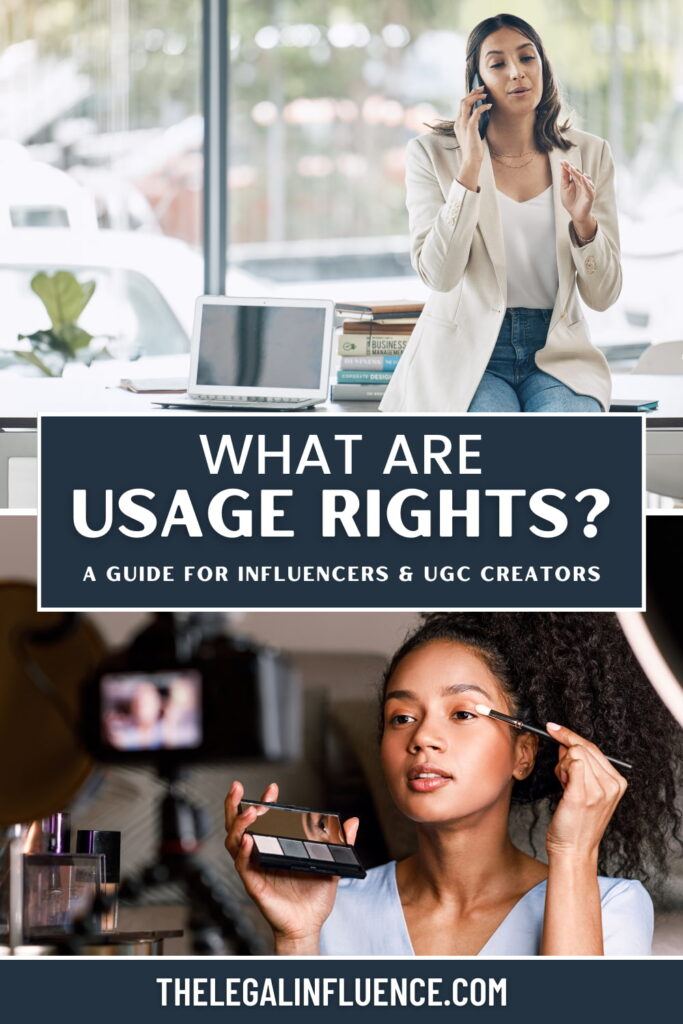The information contained in “What Are Usage Rights? Guide For Influencers & UGC Creators“ is for informational and educational purposes only. It is not to be construed as legal advice. Reading this article or relying on information from this article does not ever create an attorney-client relationship between you and Katherine Jaquith (aka Kate Cooper). Please speak with a licensed attorney for individual advice.
If you’re new to working with brands as a content creator you may be wondering, what are usage rights?
To put it simply, usage rights allow a brand to use an influencer or content creator’s content in some capacity. The specific language included in the brand deal contract will determine what the brand can do, where the brand can do it, and how long they can do it for.
Whether you’re an influencer or UGC creator, it’s important to understand what usage rights are so you fully understand the scope of your brand deal and can negotiate a fair rate.

Brand Deal Contracts: Licensing & Usage Rights
As independent contractors, influencers and UGC creators own the intellectual property rights to the original content they create. During a brand deal, creators often license their content to the brand. This license is what allows the brand to use an influencer or UGC creator’s content.
There are many ways a brand can use content but common uses include, posting the content on the brand’s social media accounts, running paid ads behind the content, and whitelisting or dark posting the content. Usage rights are something that should always be discussed when negotiating a brand deal.
The scope of the usage rights are just one piece of the license that an influencer or content creator gives to a brand. Other important licensing terms include:
- The duration of the license. Is it for a limited time or is it in perpetuity (aka forever)?
- Is the license exclusive or non-exclusive.
- Where can the license be used? Worldwide or only in certain countries?
- Whether or not there are any royalties associated with the license.
- Whether the license can be transferred or sub-licensed.
- Whether or not the license can be revoked by the creator.
NOTE: Influencers and content creators do not retain ownership of the intellectual property rights to the content they create if the contract specifies that it is a “work made for hire” OR if the content creator is an employee of the brand.
Influencers vs. UGC Creators: Usage Rights
Influencers are primarily hired by brands to create content to post to their own social media accounts. During an influencer campaign, the brand MAY also acquire usage rights to the content the influencer creates, or they may not. Usage rights are an extra piece of value that an influencer can provide, which means they should be compensated for those rights above and beyond their base rate.
UGC creators, on the other hand, are specifically hired by brands to create content for the brand to use. That means you will ALWAYS see usage rights included in a contract for a UGC or content creation partnership. The extent of those UGC usage rights will impact the rate the UGC creator can charge for a content creation campaign.
Keep in mind that UGC creators are just one type of content creator. Product photographers and other content creators work with brands in a similar capacity by licensing their original content for the brand to use.

Usage Rights: Terms Every Content Creator Should Know
There are a number of different ways that a brand can potentially use a creator’s content. It’s important to read the licensing and usage provisions in a brand deal contract carefully and understand what everything means before signing the agreement.
Knowing what a brand is going to do with a piece of content is also important when it comes to setting your rates as an influencer or UGC creator. For example, the right to run paid ads behind a piece of content is going to be much more valuable than the right to simply post that content on social media. How long the brand can use the content will also affect rates.
The following are some common terms you may see in a licensing & usage provision in a brand deal contract. If you have any questions about a specific term in your contract, ask the brand for clarification or work with an attorney. Ultimately you want to make sure that you and the brand are totally on the same page when it comes to what the brand can (and cannot) do with your content!
Organic Social Rights
When an influencer or UGC creator gives a brand organic social rights, they are giving the brand the right to post the content on its own social media channels. The terms may specify which social media platforms the content can be posted on and how long the brand has to post the content.
Paid Usage Rights
Paid usage rights allow a brand to run ads behind the content. You may see paid usage rights described in a number of different ways: “paid media rights”; “paid marketing rights”; “the right to use the content in paid advertising”; etc. If there’s any confusion or ambiguity, ask the brand for clarification.
Paid usage rights are incredibly valuable for brands because it gives them the opportunity to directly monetize and profit from a creator’s content. Running ads allows a brand to target the audience they want to reach. They also have greater control over how many times a piece of content is seen. A brand could potentially put a substantial amount of advertising dollars behind a piece of content, so it’s important that influencers and UGC creators are compensated appropriately for paid usage rights.
Whitelisting and Dark Posting
When a brand acquires whitelisting rights, it means they have the right to run ads behind a piece of content the creator posted to their social media feed. The ads look like they are coming from the creator’s account, however the brand is controlling the ad, including how much money is being spent on it. An influencer can give a brand whitelisting access directly through social media platforms like Facebook, Instagram, and TikTok (referred to as “Spark ads”), when the influencer posts a piece of sponsored content.
Dark posting is similar to whitelisting in that the brand is running ads behind content that looks like it’s coming from a creator’s account. However, with dark posting the creator doesn’t have to post the content to their feed. The brand takes care of everything on the backend, so the content never appears on the creator’s page.

Do You Need a Brand Deal Contract?
Looking for a brand deal contract with customizable usage rights terms that are drafted to protect creators? Check out the DIY Influencer Agreement and Content Creator Contract templates in The Legal Influence Contract Shop.
Pin It For Later:


View comments
+ Leave a comment